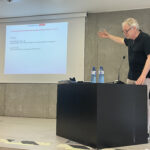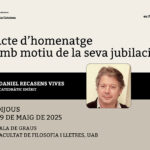14 setembre, 2019
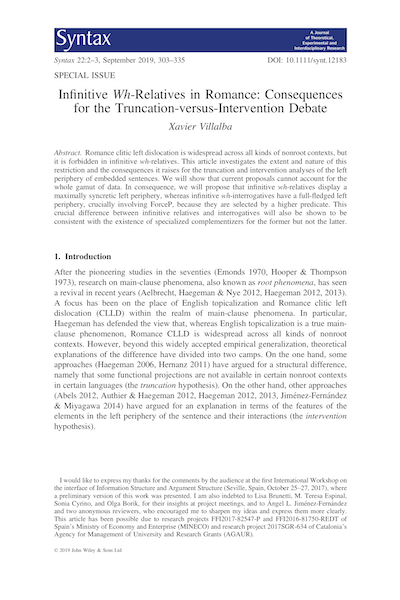
Autors:
Xavier Villalba
Títol:
Infinitive Wh-Relatives in Romance: Consequences for the Truncation-versus-Intervention DebateEditorial: Syntax, vol.22:2–3 \\ Double Special Issue: Information Structure, Argument Structure, and Their Interfaces
Data de publicació: Agost de 2019
Més informació
Text completRomance clitic left dislocation is widespread across all kinds of nonroot contexts, but it is forbidden in infinitive wh-relatives. This article investigates the extent and nature of this restriction and the consequences it raises for the truncation and intervention analyses of the left periphery of embedded sentences. We will show that current proposals cannot account for the whole gamut of data. In consequence, we will propose that infinitive wh-relatives display a maximally syncretic left periphery, whereas infinitive wh-interrogatives have a full-fledged left periphery, crucially involving ForceP, because they are selected by a higher predicate. This crucial difference between infinitive relatives and interrogatives will also be shown to be consistent with the existence of specialized complementizers for the former but not the latter.
17 febrer, 2020
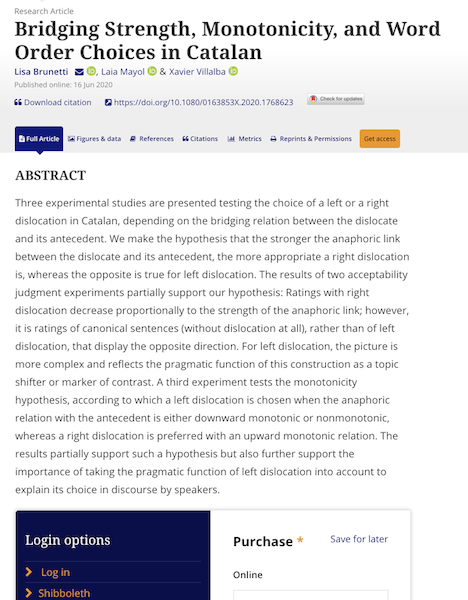
Autors:
Lisa Brunetti, Laia Mayol & Xavier Villalba
Títol:
Bridging Strength, Monotonicity, and Word Order Choices in CatalanEditorial: Discourse Processes
Data de publicació: Juny de 2020
Més informacióThree experimental studies are presented testing the choice of a left or a right dislocation in Catalan, depending on the bridging relation between the dislocate and its antecedent. We make the hypothesis that the stronger the anaphoric link between the dislocate and its antecedent, the more appropriate a right dislocation is, whereas the opposite is true for left dislocation. The results of two acceptability judgment experiments partially support our hypothesis: Ratings with right dislocation decrease proportionally to the strength of the anaphoric link; however, it is ratings of canonical sentences (without dislocation at all), rather than of left dislocation, that display the opposite direction. For left dislocation, the picture is more complex and reflects the pragmatic function of this construction as a topic shifter or marker of contrast. A third experiment tests the monotonicity hypothesis, according to which a left dislocation is chosen when the anaphoric relation with the antecedent is either downward monotonic or nonmonotonic, whereas a right dislocation is preferred with an upward monotonic relation. The results partially support such a hypothesis but also further support the importance of taking the pragmatic function of left dislocation into account to explain its choice in discourse by speakers.
18 desembre, 2020

Autors:
Xavier Villalba & Sílvia Planas-Morales
Títol:
Revista Española de Lingüística 50(2), 83-106Editorial: Sociedad Española de Lingüística
Més informació
Text completEn este artículo proponemos analizar los elementos que encabezan las relativas preposicionales de infinitivo (libros por/para leer) como complementantes preposicionales que se generan en el núcleo de SFinitud. Ello nos permite trazar claras diferencias con las construcciones preposicionales finales y causales y ofrecer al mismo tiempo un análisis uniforme para todas las relativas, sean finitas o no. También sugerimos que la lectura modal asociada a las relativas preposicionales se expresa mediante una categoría funcional específica ligada a la modalidad radical, lo que nos permite explicar parte de las restricciones combinatorias de estas relativas. Por último, proponemos extender este análisis a las relativas de infinitivo introducidas por que (libros que leer).
6 març, 2022
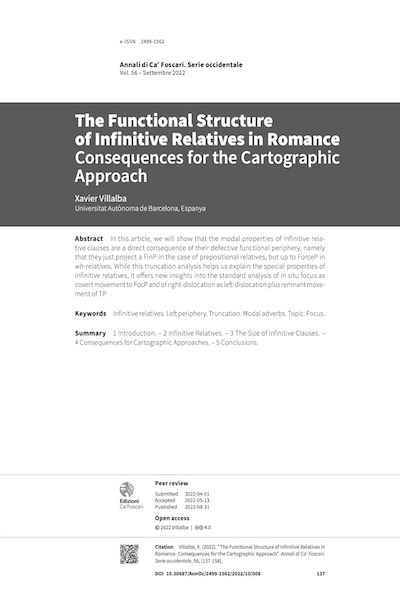
Autors:
Xavier Villalba
Títol:
The Functional Structure of Infinitive Relatives in Romance. Consequences for the Cartographic ApproachEditorial: Annali de Ca' Foscari, Venice University Press
Data de publicació: 31 agost 2022
Més informació
Text completIn this article, we will show that the modal properties of infinitive relative clauses are a direct consequence of their defective functional periphery, namely that they just project a FinP in the case of prepositional relatives, but up to ForceP in wh-relatives. While this truncation analysis helps us explain the special properties of infinitive relatives, it offers new insights into the standard analysis of in situ focus as covert movement to FocP and of right-dislocation as left-dislocation plus remnant movement of TP.







